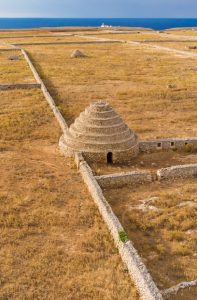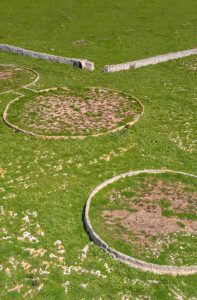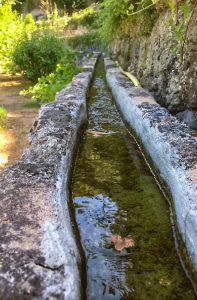Having visited hundreds of country estates in Menorca, what strikes me most about these properties is the high level of self-sufficiency and sustainability they have achieved in the past.
Each property produced all the perishable foods it needed (dairy products, meat, vegetables, fruit, etc.), as well as obtaining its own wine, oil, spices, clothing fabrics, wood, lime, even tobacco and a host of other things…
The “Lloc” (a Menorcan word used to describe a large estate) was a kind of small independent kingdom that was perfectly organised.
Each architectural complex within a farm was wisely designed to achieve the highest degree of efficiency in farming and the use of natural resources.
Architectural organisation of a country estate
A Lloc is a rustic property that rarely has less than 10 hectares of land and usually has from 50 to more than 100 hectares in many cases. Smaller properties without exploitation are called “estancias”.
Each property has an architectural ensemble that is astutely designed, the result of centuries of experience, mainly to carry out the agricultural activity with maximum efficiency.
The construction elements within the rMenorcan country estate, with some anecdotal variations to be taken into account, are configured as follows:
The main house “El Casat” (house with a covered porch), normally two storeys high and in some cases up to three. The ground floor is inhabited by the farmers or “amitgers” (they are known in this way because they traditionally exploit the property at 50% with the owner), and the upper floor of the house is inhabited by the owners.
In addition, all the properties have a south-facing work courtyard (almost always paved), storerooms, auxiliary work buildings, henhouses, stables, barns, wells, water tanks, and drinking troughs, wheat threshing circles (there are normally always two), shelters for animals and huts (shelters for animals of very primitive origin), bread ovens, and other minor constructions.
Sustainable architecture in Minorca
On rustic properties everything revolves around the maximum use of natural resources. Nothing is superfluous or merely decorative.
The ‘marés’ blocks (local limestone formed by sediments) were used to construct the buildings and were extracted from somewhere on the estate itself, thus avoiding efforts and waste of means of transport.
The painted white roofs are not painted on a whim. The white lime paint protects the tiles from the erosion of the saltpetre brought by the wind, cools the temperature of the interior in summer and sanitizes the process of collecting rainwater that circulates through the painted roofs and gutters to the water tanks.
All the houses, almost without exception, face south to make the most of the sunlight, and the north facades have small windows to protect them from the north wind and avoid unnecessary carpentry maintenance.
The arches on the facades (semicircular arches paired and separated by pillars) serve to provide shade in the summer and shelter from the wind in the cold months.
The thick walls maintain a pleasant temperature inside the house throughout the year and the rooms facing north are rarely inhabited, being used as a work space like a cheese factory, storeroom, workshop, etc.
The porches or attics of the house were used only to store food and, at the same time, to create an air chamber to isolate the inhabited area of the house.
Even the lime used for painting was obtained on the estate itself thanks to the process of roasting the stones in lime kilns.
Sustainable Agriculture and Livestock
The size of the herds as well as the number of cultivated hectares was always measured taking into account the extensions, the contours, and the resources on the property.
The use of rainwater and other possible water resources such as wells, streams or natural reservoirs deserved careful study.
The natural rock falls were also used to direct rainwater to small water tanks located at various strategic points on the property, which were used as a water supply for the livestock and for irrigation.
It was traditionally cultivated using the fallow system, respecting the natural cycles of the land, and without the need for fertilisers or artificial chemical products.
The orchards were located on the most protected plots of land on the property and were irrigated by means of ingenious systems of stone channels that transported the water from the water tanks.
Labour organisation on a Menorcan country estate
A family composed mainly of “L’amo” (the farmer) and the “Madonna” (the farmer’s wife) and their children, were responsible for running and exploiting the farm, with the help of “missatges” (helpers) and, eventually, “tempores” (temporary workers) who were employed at specific times such as during the sowing and harvesting season.
Final conclusions
Despite the fact that the rural architecture in Menorca has a purely functional origin, the passing of time has converted all that austere functionality of simple but strong elements into an admirable architectural beauty appreciated throughout the world.
Today there is a lot of talk about eco-architecture, sustainability, ecology and many other related concepts that, beforehand, are presented as if they were an advance of contemporary society, but we really must be honest and admit that our current society should stop and look back; to learn from the organization and wisdom that our ancestors achieved and that we have unfortunately been losing.



If you want to know which country estates are for sale in Menorca click here
We want to be your estate agent in Menorca and help you to buy and refurbish a Menorcan property! Contact us and tell us about your project!

Leave a Reply